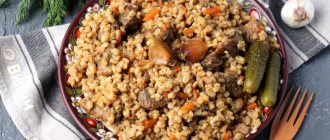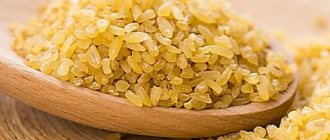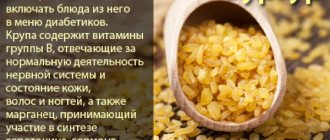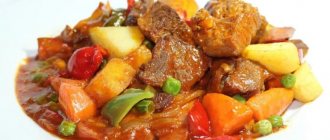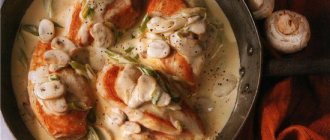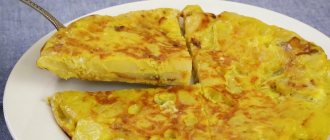Steamed or polished
Experienced chefs know what makes pilaf successful. It's about choosing the right rice. Considering the variety of this cereal on store shelves, it is worth learning to understand its varieties, types and quality.
Steamed and polished have already undergone certain processing to improve taste. But are both suitable for preparing oriental dishes? Steamed or heat-treated rice is the best for many cooks; it has a crumbly structure and absorbs moisture well. The prepared food comes in large quantities and is rich in vitamins.
Polished grains are rarely purchased for pilaf, since after deep processing they acquire a smooth shape, translucent, white color, vitamins and microelements are practically absent. It is better to use this product for preparing viscous porridges.
Features of steamed rice
On store shelves you can find two varieties of rice grains of different sizes and shapes: polished or steamed. The last type undergoes special processing before sale. First, it is filled with water, removing starch, which often causes the porridge to stick together. Next, the cereal is doused with high-temperature steam. As a result, the grains acquire a golden hue and a transparent structure, as can be seen in the photo. During the cooking process, this rice retains its shape and the grains do not stick together.
Which rice to choose for pilaf
This question is asked by many inexperienced housewives. Sometimes you can find the inscription “for pilaf” on the packs, but often this is just a marketing ploy. The price/quality ratio is not always justified. Quite expensive varieties are often counterfeited by coloring ordinary rice. This is easy to check: if the water turns colored during soaking, it means you purchased a fake. Also, the Chinese have long learned to mix synthetic resins with starch, from which they form grains.
The main requirements for cereals for pilaf are: hardness, ribbed structure, grain integrity - a high-quality cereal will not break, burn in dishes, have a clearly different yellowed or white appearance, stick together, and must absorb water, aromas of seasonings and fats well.
To prepare oriental food, today it is better not to use crushed, finely polished cereals, because they contain a lot of starch. When cooked, the grains stick together and swell. But Soviet housewives could not afford to often buy high-quality imported cereals and resorted to a little trick - first they fried ordinary cheap rice in oil. With this method, the starch is “sealed” in it, and the grains do not lose their shape.
Devzira is the best long-grain variety, but also the most expensive, which can expand seven times during heat treatment, perfectly absorbs aromas, and always turns out crumbly. It was created specifically for pilaf, bred by breeders. The cereal has a pleasant beige color, a sweetish taste, and contains almost no starch. Preparing a real tasty oriental side dish from devzira is not difficult. A characteristic feature is its weightiness.
How to cleanse yourself with dried soaked rice
For those who are going on a trip, but would like to cleanse their joints with rice on vacation, we can recommend cleansing the body with rice, previously soaked, washed and dried. It’s easy to take this cleansing rice with you on vacation or a business trip. Cleansing the body with rice should be carried out after preliminary preparation:
- pour 10 liters of water into 3 kg of rice grains (it is advisable to use round rice);
- the next day, rinse the rice thoroughly and soak again overnight;
- wash and soak the rice for another 3-4 days until all the starch is removed from the grain (as a result of which the drained water will become clear);
- place the rice in a sieve, and when the water has drained, spread it in a thin layer on a tray or baking sheet;
- Place the dried rice into a paper or linen bag.
Rice processed in this way can be eaten in the morning in the form of porridge, cooked from 1 tablespoon of cereal, or raw (grains - according to the number of years), washed down with a small amount of water.
Brown
Brown or brown cereal has many advantages: unusual taste, low calorie content, and a minimum of starch contained in it. It consists of unpolished cereals that are minimally processed and retain a greater amount of beneficial microelements. The grains have a slightly nutty aroma that lingers during cooking due to the bran shell. They contain amino acids, proteins, essential dietary fiber, B vitamins, and minerals. When consuming the product, the body receives slow carbohydrates, which take a long time to be consumed, and hunger occurs much later than usual.
The disadvantages are the high cost and short shelf life.
The most popular brown rice is indica. This variety undergoes very careful processing and preserves the embryos that are beneficial to the human body. When sprouted, high-quality grains always sprout.
White
White polished rice is familiar to everyone since childhood. It is the cheapest, but stores well. You can quickly cook porridge from it (in about 15 minutes). But in terms of health benefits, it is significantly inferior to brown rice - white rice does not have a bran shell. The shapes are divided into long-grain (practically does not stick together), medium-grain (becomes soft), round (quickly sticks together). But there are varieties of white cereals that are well suited for pilaf. Among the best white grains for pilaf are Basmati (long-grain, with proper preparation the volume doubles, the product turns out crumbly), Arborio (medium-grain, round-grain, remarkably absorbs the odors of spices and meat), Krasnodar (round, slightly elongated), Jasmine (does not boil and does not stick together).
How to soak rice
To prepare pilaf, it is better to take good rice and be sure to soak it. Why soak? Rice is mostly starch, which, when cooked, is released into zirvak or water and becomes jelly in it. This paste blocks the entry of oil into the interior.
So, if you soak it before cooking, and also rinse it well before soaking, the chances of getting the pilaf you want will increase sharply, and the result will be very good.
You should soak only in the best, cleanest water, because it will be part of your dish!
What temperature should the water be?
Some say that it is better to soak it in boiling water. Others are sure that rice should only be soaked in cold water. The third advises: “Soak the rice in hot water, and then pour in cold water” ... are there any rules that help prepare the most delicious, authentic pilaf?
Truth can be established by practice and experience. To ensure that the pilaf is crumbly and rich in oil and everything else, we recommend soaking it at a water temperature of only 60 degrees.
Then some will be hard, some will be loose, and the cooked pilaf will be sticky. After all, the starch was boiled quickly, did not go into the water with soaking, but was boiled down and turned into a paste in the dish. It is possible to eat, and even nutritious, but not appetizing.
Cold water is a good option, but it takes longer to soak. So it is better to take moderately hot water and well-washed cereals.
One more point: people begin to navigate the process of cooking pilaf with experience. While there is no such experience, know that if the rice suddenly becomes very swollen during soaking, then less zirvak (or water added to it) is needed; swollen rice absorbs little fat and broth.
One of the popular methods of healing and improving general condition is cleansing the body with rice (rice therapy). The use of this product allows you to get rid of salts and other harmful substances that impair the functionality of vital organs. In order for cleansing to be effective and not cause harm, you must follow the rules and take into account existing contraindications.
Krasnodar
The most fluffy rice is long grain rice. Despite the fact that Krasnodar rice is a soft variety, there are cereals containing large amounts of amylose. Thanks to it, the rice keeps its shape perfectly during cooking. These varieties include Flagman, Regul, Khazar, Rapan. They contain up to 25% amylose.
In order for the side dish of Krasnodar rice to turn out “as it should,” certain culinary rules must be followed. First you need to rinse the rice until the water is clear, dry it in a colander and pour it into a saucepan with a thick bottom. Add a tablespoon of oil and, stirring, keep on fire for 1-2 minutes. Pour 3 cups of boiling water over the product and cook for 20 minutes over low heat, adding salt 5 minutes before it’s ready. Boil, drain again and rinse. After this, add oil to the side dish. The result is an elastic, slightly sweet and soft product.
What you need for cooking
If we consider the version of Uzbek pilaf, which is traditionally prepared from long-grain rice, then it will require the following products:
- vegetable oil – 100–150 ml (the classic recipe uses cottonseed oil);
- steamed rice – 500 g;
- lamb – 500 g;
- carrots – 3 pcs.;
- onions – 2–3 pcs.;
- garlic – 1 whole head;
- spices: hot pepper and cumin;
- salt;
- bay leaf (optional).
In fact, there is no standard pilaf recipe that you need to follow. Different countries prepare this dish in their own way. For example, we often cook it with pork, whereas in oriental cuisine this meat is not present at all. There, young mutton (lamb) or beef is used for pilaf. In Tatar cuisine, pilaf is prepared with chicken, and with beef or lamb, of course.
There is also no standard set of spices. It is hardly possible to imagine pilaf without some pepper. This product can be ground, in the form of peas, a mixture of peppers, it is also good to use hot peppers in a pod. To give the pilaf a spicy taste, cumin (cumin) is added, turmeric is added for a beautiful color, and dried barberry is added for a rich taste and aroma.
If you want to make the taste of the dish softer and sweeter, add raisins or dried apricots.
You can also find prunes in many recipes. In general, you can experiment with a set of products for pilaf. Only 4 ingredients remain unchanged: rice, meat, onions and carrots. The rest of the products are a matter of taste and preference.
What else is required to prepare good pilaf is a cauldron with a thick bottom and walls. If pilaf is often on your table, then you definitely need to get such utensils. A more modern option is also suitable - a wok frying pan, which looks very similar to a cauldron, in which it is customary to cook a dish in Asian countries, or an ordinary wide frying pan with a non-stick coating.
Long or round
Many professional cooks prefer round rice, believing that it makes pilaf more juicy and tasty. It can be prepared in a pressure cooker, slow cooker and on the stove. Do not stir the finished side dish.
For someone who is not an expert in preparing oriental cuisine, it is easier to take a long one, as it will be more difficult to digest. It comes in white, brown and black. But mostly they use white and steamed. Cooking time is about half an hour. If long grain rice is washed well, the pilaf will definitely turn out crumbly.
Relation to water
The question often arises of how much water should be used to prepare pilaf. After all, it depends on how the dish turns out - tasty and crumbly, or dry or wet, like porridge. How much water to add to pilaf depends on the method of its preparation. For example, for traditional Azerbaijani pilaf, all ingredients are boiled and cooked separately, after which they are mixed in a cauldron. This method of preparation requires 3 times more water than the main product. For Uzbek-style pilaf, all products are added one at a time and cooked together. The cereal is poured with boiling water at the rate of 1 to 2.5. The simplest solution would be to take the amount of water that will cover the rice and meat by 2 cm.
How else is it possible to cook
Delicious pilaf can be prepared not only in a cauldron, but also in a slow cooker. If your “assistant” has the corresponding function, then the steamed rice will show its best qualities, become quite soft and at the same time will not lose its crispness. The ingredients for the dish are listed above, but if you want to cook pilaf without first stewing the meat, then it is more advisable to use poultry - it is cooked at the same time as the rice.
Delicious recipe! Beef tartare recipe from Ivlev
To immediately put all the products into the multicooker, prepare them in advance: rinse the rice, peel and chop the onions and carrots, cut the meat into small pieces and fry if the recipe requires it. You can fry vegetables and meat immediately in the multicooker bowl, after which all that remains is to add rice, spices and add water.
If only a multicooker is used to prepare pilaf, then the process will look like this:
- Fry the meat in the “fry” mode for 10 minutes.
- Add chopped vegetables to the meat (onion in half rings, carrots in strips), and fry in the same mode for another 5 minutes.
- Add spices, salt, garlic, a couple of glasses of water to the multicooker bowl, and turn on the “stew” mode for 20 minutes.
- Then add rice and add enough water to cover all the ingredients by 1-1.5 cm. We put the machine on the “cook” mode for 40 minutes. The set of functions differs in different multicookers; yours may have a “rice” or “pilaf” mode.
- After cooking the pilaf, do not open it, but let it stand for 15 minutes. Then stir and serve with fresh vegetables and herbs.
You can prepare different versions of pilaf from steamed rice: with fish, seafood, mushrooms or vegetables.
The process of preparing such a dish will be slightly different from the classic recipe with meat. It should be borne in mind that vegetables and mushrooms cook quickly, while fish and seafood only need a short steam treatment. Therefore, it is better to first cook the rice with fried carrots and onions until half cooked, and then add the rest of the ingredients. In general, experiment and don’t doubt your success. Bon appetit!
Cooking pilaf often confuses housewives, because not everyone can make a crumbly, appetizing oriental dish. To ensure that the pilaf comes out as it should and does not resemble a sticky porridge, use steamed rice for cooking. This cereal has a denser shell, so your chances of getting real pilaf increase significantly. Chefs recommend using long-grain steamed rice; it will successfully replace expensive Asian varieties.
Why does it turn out like porridge?
To make the pilaf really tasty, you shouldn’t rush during cooking. Often it can turn out sticky, like porridge, and several reasons can contribute to this. Starchy rice was originally intended to be sticky, making it suitable for dishes such as risotto. If the grains were poorly washed, a lot of starch will remain on them, due to which the grains stick together. Lack of soaking of certain varieties leads to soggy and sticky
An important condition is the correct cooking time. Overcook the cereal and you end up with porridge. This also applies to carrots in pilaf.
If you notice that there is too much water and the grains are already cooked, it is better to turn off the heat and cover the dish with a lid. Water, if there is not a lot of it, will be absorbed. If there is too much water, you will have to evaporate it, but the end result will be a regular tasty porridge.
You can also add a small amount of fat and try drying it by frying it in a frying pan or in the microwave. Fat separates the grains from each other. But the dish will turn out to be quite fatty, so this method is not suitable for people with gastrointestinal problems.
If it didn't work out
So, what you feared happened: it turned out to be tasty, but a porridge with meat. There is nothing that can be done to correct anything at this point. But you need to draw conclusions and not give up culinary experiments.
The rice in the pilaf may stick together, or, on the contrary, it may be dry.
Why does it turn out like porridge?
Pilaf turns into mush for several reasons. Rice grains lose their shape:
- More water than necessary. For example, rice was soaked longer than necessary or excess water was poured into the pilaf.
- The pilaf was overcooked.
- The rice was originally crushed. Or, when washing, long grain rice was broken by rubbing it between the palms.
Lots of starch:
- Poor quality washing of rice, and rice powder got into the pilaf.
- Starchy variety. Here, either refuse such rice or try to fry it before preparing pilaf.
- We disturbed the pilaf with a slotted spoon, and the cooked rice crumbs fell into the broth and thickened the pilaf.
- And a common, common mistake: the recipe is violated, the proportions and temperature conditions are not followed.
If you are unsure of your abilities, but want to cook pilaf, we recommend starting with steamed rice - it is difficult to make it sticky.
The pilaf turned out dry
There are several reasons why pilaf turns out dry. If there is a lack of water, fat, or vegetable oil, long rice may boil but remain dry. A small amount of vegetables can cause a spoiled side dish, because they are what give it its juiciness. If the dish is removed from the stove at the wrong time, it can also become dry. High heat will evaporate water quickly, so it's best to cook over moderate heat.
It is important to remember certain rules when cooking pilaf: boiling water should be 2.5 cm higher than the grain in the pan. Vegetables should be added as much as possible, approximately 2 times the amount of grains per serving.
If the food still turns out dry, you should try to save the situation. The first way is to fry the onion and mix it with meat broth, then mix with the side dish and leave for 20-30 minutes. You can add the broth to the already prepared pilaf and keep it on low heat. If you don’t have time to cook the broth, plain clean water will do. But you need to make sure that there is not too much liquid, otherwise the dry pilaf will turn into porridge. Enterprising housewives add a little oil to the finished product (but it will be a little fatty), sauce and water (the taste of the food will change slightly).
Uzbek pilaf in a cauldron
Everything would be fine, and the recipe is almost correctly copied from the book of Stalik Khankishiev, and the pilaf is almost Fergana, but... cutting carrots into 1cm cubes is something, has anyone eaten pilaf with such cutting in Uzbekistan? I think not, according to S.H.’s recipe. you need to cut everything into long strips 3 by 3 millimeters. Next, prepare the meat: cut it into one and a half centimeter cubes, set the bone aside, and if there are slices from the back with ribs, then divide them one rib at a time and also set them aside. If you prefer pure pulp - without ribs and bones, you can use any brain bones left after cutting the meat. Let's sort through the rice and rinse it thoroughly until perfectly clean water flows from it. Then soak it in plenty of warm (but not hot) water. As we remember, a lot depends on the time of soaking rice. Now, into very hot oil (or into fat rendered from lard), carefully, so as not to get burned by the oil splashes, place the lamb bone and back slices. The ribs fry very quickly: turn them over once or twice, for about five or six minutes, and they become a beautiful, golden brown color. The seeds should also acquire a golden color. Remove the meat from the cauldron and put it in a dumpster. Once again we wait for the oil to heat up and put the onion cut into rings into the cauldron. Gently fry it, stirring occasionally, until red-golden in color. All the water that was in the onion must evaporate, otherwise the meat that is waiting its turn will be stewed and not fried. We still don’t turn down the fire! Speaking of oil... There is a rather risky, but effective and quick way to get rid of the smell of oil. When the oil begins to smoke, some cooks, to save time, instead of frying the onion, sprinkle a tablespoon of water over the surface of the oil. The water instantly boils, jets of steam shoot up from the cauldron, carrying along with it unnecessary odors. But, we repeat, this is a dangerous method - splashes of oil can seriously burn the cook himself. And if you cook indoors, it’s scary to think what will happen to the kitchen walls! Now let’s put the lamb pulp into the cauldron and fry the meat, stirring occasionally, along with the onion. After waiting for a beautiful crust to appear on the meat cubes, add the carrots in an even layer. After two or three minutes, mix it over the entire area of the cauldron with meat and onions - carefully so as not to break the carrot slices. Fry it, stirring, for 10-15 minutes, towards the end of frying, reduce the heat to medium, add some of the cumin. The carrots should become soft and give off a “pilaf smell.” If there is no smell, then you need to fry further. Speaking of salt... IF YOU are horrified to realize that you have over-salted the zirvak, put one or two peeled potatoes in it. Firstly, this will correct the situation with salt, and secondly, the potatoes will also turn out very tasty, and you will eat them with pleasure later. By the way, about home supplies... Freshly brewed zirvak, by the way, is well stored for quite a long time (in the refrigerator, of course). You can take up the pilaf and prepare a little more zirvak than you need for one time, pour some of it, cool it, and put it in the refrigerator. And a few days later, when welcoming unexpected guests, quickly heat up and add rice, getting ready-made pilaf in less than an hour! Pour in boiling water until everything is covered by a centimeter and a half. We lower the whole heads of garlic, previously cleared of the outer husks and roots, and a whole, undamaged capsicum.TPF 1 FPT Speaking of rice... Be careful: the water from the rice must be drained immediately before placing it in the cauldron. Soaked rice, left without water, dries out quite quickly, and the whole thing comes apart in rings, cracks and bursts. The result will be disappointing: pilaf made from cheap cut rice, although at the beginning you used a purebred, expensive variety. Speaking of water... There is a proven way to find out whether there is still water at the bottom of the cauldron, under a layer of pilaf: you just need to pat the surface of the rice with a slotted spoon. If there is still water left, a slurping, squelching sound will be heard. And if there is no water, the sound will be dull and elastic. We return the back slices or the bone that was fried at the beginning to the cauldron. After everything boils, you need to reduce the heat to “just above the very minimum.” Everything should boil in an open cauldron for about forty minutes, no less. The water should gradually boil away, and the remaining broth should become transparent and acquire a rich red-brown color. TPF 2 FPT Having achieved the desired color and consistency, turn up the heat again to maximum and add salt. If you cooked with a bone, remove it; you won’t need it anymore. TP 1 PT If your pepper is fresh and juicy, then this can be done later, but if it is dry and hard, then right now. The same applies to garlic - if it is spring, young, it can be put in pilaf much later, along with rice. It doesn’t matter whether she likes baked garlic and pepper or not: they need to be put in anyway, even if you throw them away later. TP 2 PT “Where is the barberry? Real Uzbek pilaf should contain barberry!” - well-informed readers may be indignant. Well, add barberry too, if you want. It is at this stage that you put it in. But, honestly, it’s not about barberry! What we got is called zirvak.TPF 1 FPT Now carefully drain the water from the soaked rice, use a slotted spoon to lower it evenly into the cauldron, leveling it over the surface, and pour about a liter of boiling water over everything - carefully so as not to damage the layer of rice.TPF 2 FPT We add fire to “supermaximum” - it is necessary that it boils as soon as possible and over the entire surface. For this, you can even break the rules and cover it with a lid for a minute! If only it boils, so that the oil floats to the top, and then, in the process of cooking the rice and evaporating the water, it sinks down again, enveloping each grain - then there will be pilaf, and not a sticky porridge with meat! Under no circumstances do we mix rice with the lower layers of carrots and meat, only level the surface of the rice if necessary, and regulate uniform boiling by moving the rice from where it boils less or not at all to where there is active seething, and level again . By the way, about pepper... If YOU, IN the bustle, forgot to put dry pepper pods on time, then there is a clever way to correct this mistake. Just before closing the pilaf, when there is no water left in the rice, cut off the tails of the peppers, shake out all the seeds from them and insert the sharp end into the rice. Carefully pour a little boiling water into the peppers themselves. And close the pilaf with a lid, as usual. The peppers will turn out well baked and very tasty, without giving too much heat to the pilaf itself. TP 1 PT Usually you need about a heaping tablespoon of salt for such a quantity of starting products, but it’s better to try: the broth should be slightly salted, since some of the salt will then be absorbed by the rice. TP 2 PT It is important here not to pour too much: each time the volume of water is selected in accordance with the properties of the rice, the strength of the flame, and so on. It’s better to pour a little less and add it later, trill the gem and immediately ruin everything. We need all the rice to be covered with water by about a centimeter and a half, no more. When the water completely disappears from the surface, try the rice. It, having noticeably increased in volume, should not crunch on the teeth. That is, the rice is almost ready, but there should be no water left in the cauldron at all. Use a slotted spoon to remove it from the edge and see: is there only oil there, or is there something squelching at the bottom, raising steam? By the way, about fat content... It is very rare, but sometimes it happens that there is too much oil in pilaf. In this case, you need to take a stale flatbread (or churek, or maybe even lavash), spread it into thin plates and place them at the very bottom of the cauldron. These pieces will absorb all the excess oil, leaving only as much as needed. If there is too much water left, make holes in the rice layer so that it boils out more intensely from below; you can even use a slotted spoon to move the rice layer around the edges. If, on the contrary, it is dry below, but the rice is still crunchy, add a little boiling water (literally a quarter of a glass, if it turns out to be not enough, it is better to add it later). However, if everything was done correctly, then there is no need for these actions. Having felt that everything is going “as it should” and the remaining water is about to evaporate, we reduce the heat to medium-low, wait until the water has completely boiled away, and then reduce the heat to minimum. Now sprinkle the rice with lightly ground cumin and close the cauldron with the tightest lid. If you don’t have a lid that would cover the cauldron perfectly, cover it with a large dish (it doesn’t matter if there is a small gap at the edges), and then also with a lid. We wait 20-25 minutes and open. Be careful - the first jets of steam are very hot! Loosen the rice and find the pepper pods and garlic. Carefully, so that they do not break, transfer them to a separate plate. Mix everything thoroughly, shaking the rice. If we come across lobes of the back, we’ll catch them too and set them aside for now. Place the pilaf on a large round dish in a heap, place the heads of garlic at the very top, decorate everything with pepper pods and back slices. And - they carried it!!! Pilaf is eaten with spoons. It is even more correct, having a certain dexterity, to eat with his hands. But not with a fork! Eating pilaf with a fork is an insult to the cook: the fact is that a well-made pilaf should be crumbly, this is one of the most important criteria for its quality. Well, how do you eat crumbly pilaf with a fork? It will crumble! You can only taste good pilaf with a fork... Moreover: everything will exactly correspond to oriental etiquette if you eat pilaf straight from the large common dish in which it is served. A goth who likes it spicy breaks off a piece of pepper and squeezes the contents directly onto the rice in front of him. The garlic turns out unexpectedly tasty; it is broken into cloves when it has cooled slightly, and the contents of the cloves are also squeezed onto the rice: this baked pulp will support your appetite when for the first time it seems that you are already full. After pilaf we no longer drink any alcoholic drinks or soft drinks. Only hot tea. Green, of course!
